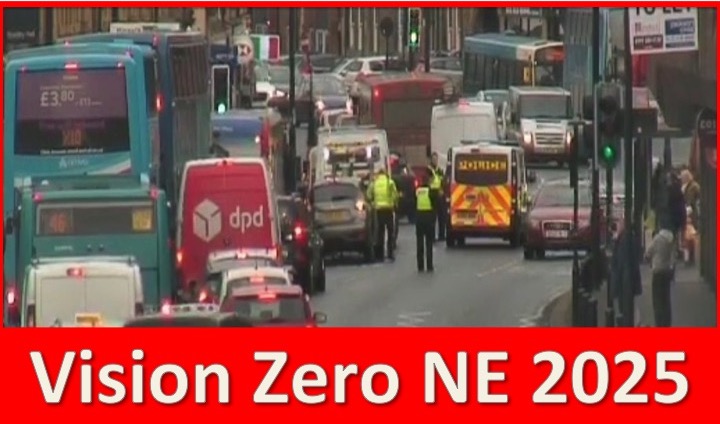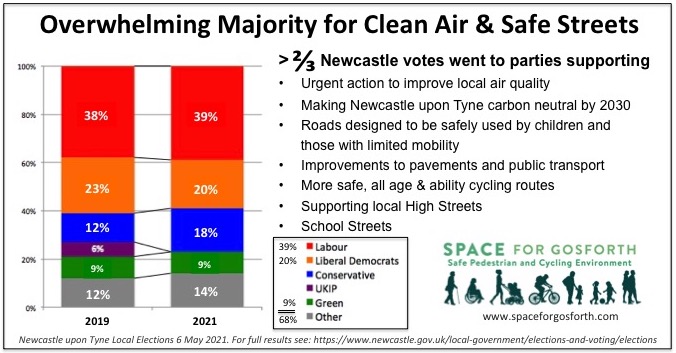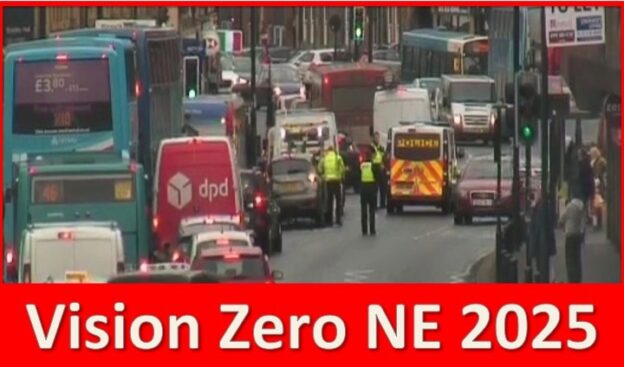
Traffic engineering is frequently a compromise between vehicle speeds and people’s safety. Higher speed limits and multi-lane junctions allow traffic to pass more quickly but, when collisions happen, people are more likely to be hurt and their injuries are likely to be worse.
Many of us will be aware of Layton Darwood (age 5), Melissa Tate (age 10), George ‘Geordie’ Bilclough, Emma Guilbert, Ann and Lawrence Nickerson, and many others who have been killed in recent years in Newcastle due to road traffic collisions.
Serious road traffic injuries can also be devastating and life changing. In this blog we share some examples reported locally in the last few months. We also share some good news about what Councils in the North East are doing to stop people being killed or seriously injured on the roads in future.
Example 1: “The 19-year-old victim, an undergraduate who was on her way to Ikea in her mum’s Fiat 500, suffered devastating injuries that left her needing a plate and screws being fitted into her broken pelvis. The student spent four months on crutches after the crash and could face long term implications from her injuries, including early arthritis.”
He left a 19-year-old with devastating injurieshttps://t.co/rlIi43incQ
— The Chronicle (@ChronicleLive) June 11, 2021
A Compromise Between Vehicle Speeds and People’s Safety
What is this ‘compromise’? In Newcastle, official road collision data shows that on average, 4 people are killed every year, 92 are seriously injured and a further 780 are slightly injured. Across the North East there were 622 deaths, 8,328 serious injuries and 59,572 slight injuries recorded between 2010 and 2019.
Despite these frighteningly large numbers, changes to improve safety for children and other vulnerable road users are often loudly opposed by a loud minority of people unwilling to accept an alternative compromise in which fewer people are killed or injured.
This is despite substantial evidence that investing in ‘faster’ roads results in more traffic rather than any time saving due to induced demand.
Example 2: “Bethany Oliver was 18 when a collision caused by a speeding driver robbed her of the ability to walk and talk Since getting out of hospital, she has spent five years living at the Alan Shearer Centre, where she receives constant specialist care.”
Bethany Oliver was 18 when a collision caused by a speeding driver robbed her of the ability to walk and talk https://t.co/u7UcskPg0R
— The Chronicle (@ChronicleLive) June 8, 2021
Step 1: Set a Target Vision Zero
Thankfully, it looks like there will now be a much greater focus on keeping people safe, with a new regional target set to end deaths and serious injuries on our roads.
Transport North East has stated its “aim is for there to be no fatalities or serious injuries on the regions’ road network by 2025.”
This is set out in the final North East Transport Plan, approved on 16 March 2021 by The North East Joint Transport Committee representing Newcastle, North Tyneside, Northumberland, Durham, Gateshead, Sunderland and South Tyneside Councils.
No fatalities or serious injuries is often referred to as Vision Zero, an approach to road safety originally from Sweden but now adopted across the world. SPACE for Gosforth supports the Vision Zero approach, and has previously urged Newcastle City Council to join other cities around the UK in adopting the Vision Zero charter and target.
In Vision Zero, responsibility for road safety is shared between road users and transport planners, so transport planners take responsibility for designing road layouts to minimise the chance of death or serious injury.
We also asked Police and Crime Commissioner candidates if they would support Action Vision Zero’s priorities for how to keep us safe when travelling in our local communities.
Example 3: “Cellist Laura Armstrong’s main artery was destroyed, meaning she needed a vein graft during emergency surgery. What followed was a series of major operations, including an 11 hour procedure involving skin and nerve grafts. Almost two years on, she’s still undergoing significant treatment. Devastatingly, the 23-year-old’s injuries also meant she was unable to continue with her master’s degree at the Royal College of Music.”
Newcastle musician left with horrific injuries after being hit by a lorryhttps://t.co/kq2RbW04Lc
— The Chronicle (@ChronicleLive) June 12, 2021
Achieving Vision Zero
2025 is an ambitious target. To achieve this Councils will have to act quickly and do more than just run adverts asking people to change their behaviour. To actually achieve Vision Zero, roads and junctions need to be designed not just to minimise the chances of a collision but also to minimise the impact when there is a collision.
The most effective measures to cut road deaths and serious injuries focus on reducing road danger. These include:
- Setting speed limits so people are not seriously injured when collisions do happen, including default 20mph speed limits in urban areas.
- Low Traffic Neighbourhoods to reduce traffic and speeding on residential streets.
- Narrower lanes to curtail higher speeds and make roads safer.
- Safer road crossings.
- Protected cycle lanes.
- Police enforcement targeting the most dangerous behaviours, sometimes called The Fatal 4, and on reducing danger to vulnerable road users e.g. Operation Close Pass.
A good explanation of engineering concepts for road safety can be found in this video titled ‘Systematic Safety: The Principles Behind Vision Zero’. StreetsBlogUSA has also written about why “Not So Fast: Why Slower Is Often Better“.
https://twitter.com/NPRoadSafety/status/1405183244417605641?s=20
Example 4: “A schoolboy has had to have a foot amputated after a road accident – but the courageous youngster has vowed to get his life “back to normal” as soon as possible.”
Brave Gosforth schoolboy, 10, vows to be 'up and about soon' after heartbreak of having foot amputatedhttps://t.co/S302IxfLia
— The Chronicle (@ChronicleLive) May 28, 2021
Democratic Mandate
In Newcastle, there’s a strong democratic mandate to make these changes, and to implement trials quickly without delay. The vast majority of people voted for candidates that support safer streets as well as taking urgent action to address the Climate Emergency, which these measures will also help.

Trials such as the five bridges are consistent with manifesto promises for safer streets, addressing pollution and the Climate Emergency. The pre-trial status quo, 96 people killed or seriously injured in Newcastle on average every year, doesn’t align with any democratic mandate so there’s no reason to retain it any longer than absolutely necessary.
Priorities
This is a question of priorities, not money. Hundreds of millions of pounds of government funding is directed towards saving a few minutes on journeys, such as £220m on the A1 bypass, compared to a fraction of that on safety interventions or on enforcement of road traffic laws such as speeding. The Government’s Road Investment Strategy is forecast to cost £27.4 billion.
Spending just a fraction of that on road schemes to reduce road danger could mean many fewer families having to suffer the anguish of loss that could have been prevented.
The UK National 30mph limit has been completely discredited. 1/3rd of UK population no longer use it. The DfT advises considering rejection where people mix with cars. UN says urban norm should be 20mph. And with 70,000 casualties pa on UK 30mph roads our video explains why pic.twitter.com/dA615eWFnJ
— 20's Plenty for Us (@20splentyforus) June 27, 2021


I am very concerned about safety on Gosforth High Street. the recently imposed new coned off areas have increased the risks to cyclists as they are now force into the path of cars at several points. i am sure that this lack of space for cyclists is against local policies to encourage more journeys to be made by bike. the system is substantially more dangerous than it was before the changes were introduced. can the council please reconsider the current temporary changes and make this street safer to cycle on
Hi David,
Thanks for commenting.
Definitely, Gosforth High Street needs to be made safer so everyone who wants to, including older people and families, can cycle along it or to the shops.
The current scheme has some good bits for cycling, between Christon Road and Hollywood Avenue and between Elmfield Road and The Grove. Elsewhere, it’s a case of sharing with the traffic though that’s not particularly worse compared to before.
Actually looking at the safety stats for the last year for all road users, it suggests that Gosforth High Street is safer since it went down to one lane, which is really good news.